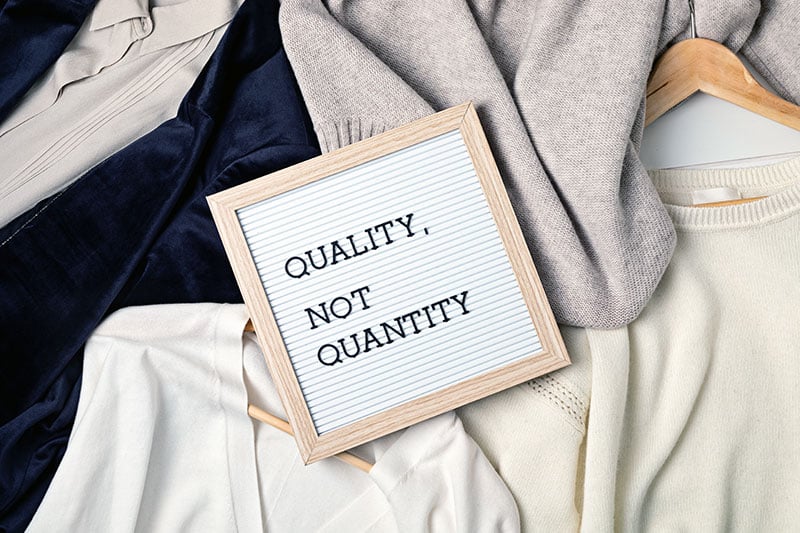5 ways to make the fashion industry more sustainable
As one of the biggest polluting industries on the planet, the apparel industry needs to change its ways, and fast.
And while there are many people who are genuinely trying to bring about change, it can be difficult for smaller brands to adopt a more sustainable business model and still stay afloat.
Difficult, but not impossible.
The fashion industry as a whole needs to step up and become more sustainable, and here are five ways they could do it.
Customised clothing
The days of mass-producing millions of garments only for them to be dumped into a landfill 6 months later need to end.
Bespoke, customised clothing may once have been only for the wealthy, but times are changing and the demand for made-to-order clothes has never been higher.
Advances in technology are mostly attributed to the trend, with automated tailoring machines creating any design ordered online. As the technology improves and we move into Web 3.0, custom-made pieces will become more commonplace, and It’s a huge area of growth for any potential brand.
It may cost more than a Fast Fashion piece off the hanger, but people are willing to pay more to have something made to their exact size.

Reduce environmental impact
We’ve talked before about how the textile industry is harming the environment, from polluting rivers with chemicals to filling the oceans with microplastics.
Around 60% of our clothes are made from synthetic material, mostly polyester, acrylic, and nylon, because they are cheaper to produce, more durable, versatile, and readily available.
If clothing brands really want to make a difference, they would switch to more natural, eco-friendly materials, such as cotton, linen, or wool.
These types of natural fibres will break down eventually, but the synthetic ones will stay around forever.
Ethical practices
Sustainability isn’t just about looking after the Earth, it’s also about looking after people.
It’s important as consumers to understand where our clothing comes from, and why going for the cheapest option isn’t always the right choice.
The vast majority of clothing made in the world is produced in Asia, in countries with very poor Human Rights records. The apparel industry employs 60 million workers globally, nearly 75% of whom are women, and the lack of ethical conditions and fair wages in the industry is shocking.
According to a European Union report, long working hours, low wages, lack of regular contracts, and systemically hazardous conditions, all make these Asian sweatshops modern-day slave trades.
If companies want to promote their ethical practices, it takes complete transparency in the supply chain. From farmers growing the cotton through to the delivery company that handles their packages, transparency is a prerequisite for sustainability.
Sustainable packaging
One way for a company to be more sustainable is through its packaging.
But even though most brands already use materials that can be recycled, recyclable packaging isn’t the same as sustainable packaging.
Recycling has been around now for decades, but it’s not enough. Sustainable packaging fits into the circular economy ethos, namely that all materials and products in society are used and circulated among people for as long as possible, in an environmentally safe, effective, and fair manner.
Ideally, sustainable packaging should be sourced responsibly, designed to be safe and effective, made from renewable energy, reusable within its lifetime, and recyclable at the end of its lifetime.
It’s one of the few areas where a company can make a big change without breaking the bank.

Change the brand’s message
Last month we talked about greenwashing and how brands use it to suggest they are doing more for the environment than they actually are. This won’t last though, with consumers getting wise to these tactics as well as new legislation coming in to stop it.
If you want your brand to be taken seriously when it comes to sustainability, then make sustainability your brand.
Embrace the future, go green. Get the message out there that you are more eco-conscious than your rivals and that you do everything possible to avoid causing harm to the environment.
If you as a company focus on sustainability, then you will attract clients who feel the same way.
Research shows that consumers will pay more if they are sure a brand is sustainable, with the younger generation more likely to open their wallets.
A greener, more sustainable future is inevitable, so why wait until you’re forced to make the changes? Do it now and get ahead of the pack.
Let us help you make the change to a more sustainable future
Here at immago, sustainability isn’t just a marketing buzzword.
We are 100% committed to improving our planet, our products and our clients. We want to see real change in the apparel industry, but we also recognise that it can’t happen overnight.
If you would like your business to make the switch to a greener future, then we can help.
Over the past 50 years we have helped hundreds of companies to grow and change with the times, adapting to whatever challenges life throws at them.
It’s our strong belief that a sustainable business practice is not only important for the planet, but also for the future survival of a business.
The more environmentally aware your brand is, the longer you will stay in business, and we can help.
Contact us today if you would like to know more about how we can help make your brand more sustainable.


